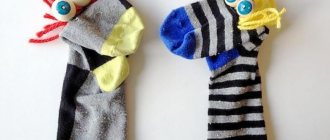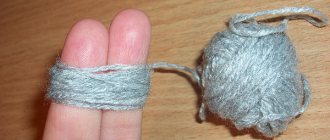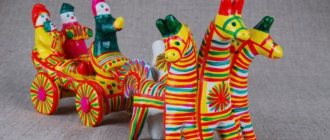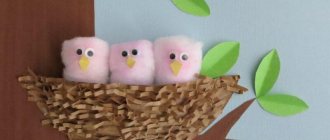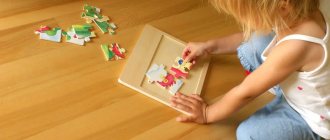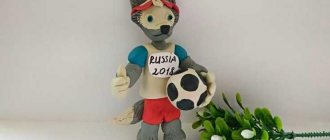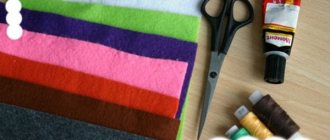Cardboard theater
An ordinary cardboard shoe box will become magical if you decorate it with fabric, secure it in the form of a curtain, and place a picture based on the plot of a fairy tale on the backdrop. You can make the decorations yourself: print or draw a chair, a chair, a table, a magic castle or a hut.
Cut a hole in the bottom of the box and attach ribbon to the side walls. Such a theater can be hung on your neck, then it will be very convenient to show scenes from figures attached to wooden skewers.
The characters are simply cut out of paper, and the manufacturing process itself is an act of improvised theater. The child can try himself as a costume designer and artist, choosing characters and scenery or a director, changing the plot at will.
Make little characters to put on your fingers. This is a very fun activity for a child.
Shadow play. How to do it quickly and easily
Step 1. Setting the stage
Take a medium sized box. Preferably 10-15 cm wide, but a box of a different width will do. You will need a ruler, pencil, stapler, scissors. We separate the box from one long side. You should get a large rectangle, one plane of which is flat without bends. ON this side we measure 5 cm from the edge. Draw the frame of the screen and cut it out. We fasten it with a stapler at the corners so that we get an L-shaped structure with a vertical future screen. Cut off the excess.
We measure out the paper that will cover the screen with an allowance for gluing. The top of the screen can be secured with a stapler. Apply paper glue to the remaining sides.
Step 2. Create characters
You will need a pencil, cardboard, scissors, a stapler, and straws for drinks. We draw characters and cut them out. In addition to action heroes, you can make the sun and clouds, birds and trees, houses and castles. Using a stapler, we attach the figures to the straw.
Step 3. Play the play
We learn a fairy tale, install a table lamp behind the screen, and play the fairy tale. Don't forget about sound effects.
Stages of creating a shadow theater
Making a shadow theater for children with your own hands combines two stages: preparing the stage and creating characters. The approximate time that needs to be spent is about 30-40 minutes. But if you start decorating and creating puppet characters, it will take a little more time.
For the theater to “work”, you will need:
- Choose a suitable light source.
- Make a screen out of a sheet, whatman paper or white paper.
- Take care of the frame (made of cardboard or an artistic stretcher).
- Correctly position the light source, screen and characters.
DIY puppet theater
To create a theater you will need a box with sides up to 10 cm high. A cookie box will do. We cover the box with colored paper using double-sided tape.
Let's start creating the curtain. The width of the curtain can be from 3 to 5 cm, the length is the size of the box. On a sheet of red velvet paper, measure the width of the curtain twice and cut off a strip. Then fold it in half, draw the outline of the curtains and cut it out. We cut the finished part along the central fold. We draw folds that imitate the drapery of a curtain with a felt-tip pen. Glue the curtain along the edges of the box.
Then we make a lambrequin. Measure 2 cm in width, draw an outline and cut it out. We measure the length of the lambrequin using the box. We cut it out, draw draperies, and glue it on top of the curtain.
Using a stationery knife, we make a slit up to 1 cm wide on the side of the box, through which the decorations will change.
Backdrops for decorations can be printed or drawn by hand. The size of the pictures must be adjusted to the internal size of the box. If the backgrounds are composed during the course of a fairy tale or play, their change will create the impression of a real theatrical action.
To make the characters you will need juice straws, double-sided tape and printed images of the characters. We fix the cut out figures on the tubes. All is ready! The show can begin.
Hand puppets for home theater
Felt doll
Will need
- Sketch of a puppet toy.
- Two sheets of felt, A4 size.
- Small pieces of colored felt.
- Thread and needle.
- Glue gun.
- A sheet of thin cardboard.
We start work by creating a pattern. To do this, draw the sketch onto a sheet of cardboard and cut it out. You will get the main pattern of the figure and individual small details: eyes, muzzle, palms, tummy, ears. The number of details depends on the choice of sketch of the puppet hero.
Then we transfer all the details onto felt. We select the color scheme according to our taste or the content of the fairy tale. The hare can be white, gray or pink, and the fox yellow or orange. If you are doing a craft with your child, let him choose what color the characters in your play will be.
We cut out the parts and pre-assemble the toy, placing all the parts in the places where they should be. If the result is satisfactory, we begin the final assembly. First, we make one main piece out of felt. We sew on all the parts that can be sewn. We sew with a buttonhole stitch. We glue small parts with a glue gun. We put all the parts together in accordance with the sketch.
If the toy has ears, we attach them last. To do this, we fold the two main parts with the right sides facing inward. We apply the ears in such a way that the edges of the part coincide with the edges of other parts, and the tips of the ears look inward. We sew all the details along the edge with a buttonhole stitch and turn the toy inside out. The glove puppet is ready, and the ears will stick out funny on the top of the head.
Sock puppet
Original dolls are made from ordinary children's socks.
To make it you will need a sock, cardboard, a small skein of thick thread or yarn, pieces of fabric for the mouth, sewing thread and buttons, and a glue gun. You can take a sock in a plain color or with a pattern, polka dots or stripes - all this will create the image of a future toy.
We make a blank for the mouth from cardboard. To do this, fold a cardboard rectangle 7 cm wide and 20 cm long in half. We round the corners along the width. From the fabric for the inside of the mouth we cut out a blank according to this template.
Trim the toe of the sock. We cut off the edges along the edge of the workpiece. Glue the cardboard blank inside the sock using a glue gun. At the same time, we fold the edges of the fabric onto the cardboard. Glue the fabric interior on top.
Making a hairstyle for the puppet. Take thread or yarn and wrap it around your hand several times. Tie in the middle and cut the ends. If you spread your fingers wide, you will get a long hairstyle. Sew the hairstyle to the sock.
Let's make eyes. We take two buttons and sew them to the sock, overlapping one on top of the other. You can use ready-made eyes or ones drawn and cut out of cardboard. You can complement the image with any details, make eyes from balls of cotton wool or add decorative elements.
Theater week for preschoolers in kindergarten
Theater week project “Theater Kaleidoscope”
Implemented the project: Vesnina O.V.
Semyonova I.S., teachers of the kindergarten “Ryabinushka” Relevance: The whole life of children is filled with play. Every child wants to play their role. Theater helps to teach a child to play, take on a role and act, while at the same time helping him gain life experience. Theater is one of the most accessible forms of art for children, helping to solve many pressing problems of modern pedagogy and psychology related to: • artistic education and upbringing of children; • formation of aesthetic taste; • moral education; • development of personal communicative qualities; • education of will, development of memory, imagination, initiative, fantasy and speech; • creating a positive emotional mood, relieving tension, resolving conflict situations through play. The subject of theatrical activities is not limited and can satisfy any interests and desires of the child. By participating in it, children get acquainted with the world around them in all its diversity - through images, colors, sounds, music. In the process of working on the expressiveness of the characters’ replicas of their own statements, the child’s vocabulary is activated and the sound culture of speech is improved. The role played, especially the dialogue with another character, confronts the little actor with the need to express himself clearly, distinctly, and intelligibly. With the help of theatrical activities in kindergarten, the child’s creative potential is revealed. Children learn to notice interesting ideas in the world around them, implement them, and create their own artistic image of a character. Therefore, it is theatrical activities that make it possible to solve many pedagogical problems related to the formation of the expressiveness of a child’s speech, intellectual and artistic aesthetic education. It is an inexhaustible source of development of feelings, experiences and emotional discoveries, a way of becoming familiar with spiritual wealth. As a result, the child gets to know the world with his mind and heart, expressing his attitude towards good and evil, and learns the joy associated with overcoming communication difficulties and self-doubt. The purpose of the theatrical week: Improving the development of creative abilities of preschool children through organizing the interaction of children and adults in joint theatrical activities. Objectives of the theatrical week: 1. To form an understanding of the theater among preschool children through excursions and theatrical performances. 2. Develop the artistic abilities of preschoolers through theatrical art. 3. Stimulate an emotionally positive perception of the theater in students, creating a zone of shared experiences. Expected results: During the implementation of the project, the following results will be obtained: 1. Pupils of different age groups will become acquainted with the history of the theater and various types of theater: finger theater, tabletop, shadow, puppet theater, drama theater, operetta.
2. Preschoolers will become familiar with the culture of behavior in the theater. 3. The level of development of acting abilities in preschool educational institutions will increase: • act freely and relaxed when performing in front of adults and peers; • improvise works using facial expressions, pantomime, expressive movements and intonation (while conveying the characteristic features of various characters); • distinguish the mood, experiences, emotional state of characters and convey them in the process of playing roles; 4 Pupils will increase their level of emotional responsiveness to works of art (music, theater, dance). Project implementation stages:
The implementation of the project includes three stages: preparatory, main and final, which are carried out in a certain sequence.
Stage I - preparatory stage
During the preparatory stage, a number of organizational measures are carried out necessary for the implementation of the main stage: studying methodological literature on the topic “Features of organizing theatrical activities in preschool educational institutions”;
obtaining and analyzing information about the interests of children and parents, selecting forms and methods of working with children necessary for carrying out activities during the theater week; creation of a subject-development environment necessary for the implementation of theatrical activities in all age groups; carrying out preparatory work for carrying out main activities. Stage II – main stage
Carrying out theater week events.
Stage III - final
The final stage is aimed at reflecting on the events held within the framework of the theatrical week. There will also be an exchange of views between teachers and parents of preschool educational institutions on the effectiveness of these events.
PHOTO REPORT ON THE THEMATIC WEEK “THEATRAL KALEIDOSCOPE”
Parents’ participation in staging the fairy tale “Turnip” in a new way
Theatrical performance based on the fairy tale “How the Chicken Got Big”
Theatrical performance based on the fairy tales “Who Said MEOW” and “Cabbage Leaf”
Participation of parents in the production of the fairy tale “The Wolf and the Seven Little Goats”
We recommend watching:
Theatrical activities in kindergarten Theater in the second junior group Do-it-yourself hat. Master class with step-by-step photos Script of a theatrical performance for children with disabilities (CP)
Similar articles:
Dramatization of Chukovsky's fairy tale The Fly Tsokotukha for children 5-7 years old
Dramatization of a fairy tale in the senior group “About the Little Mouse”
Theater performance in the senior group. Fox-sister and gray wolf
Theater quiz for the senior group
Game performance in kindergarten. Middle - senior group
Non-traditional types of theater
In addition to the usual materials for puppet theaters, alternative types can be used.
These can include plastic and wooden spoons. Images of characters are drawn or attached to them. When painting on plastic, you should use acrylic paint. If you have to paint with gouache, it is mixed with a small amount of PVA glue.
Interesting options are made from yogurt jars and plastic bottles. They are covered with colored paper, images of characters are attached and fragments of scenery are added. The results are voluminous mini-stories. Such figures do not require additional decorations and develop children's imagination.
Playing theater is a useful and interesting activity. It improves memory and develops oratory skills. The child learns to retell the text, highlight the main points, not be afraid of public speaking, and parents have the opportunity to discern the child’s talents.
Tabletop theater at home
So, what should you choose for home education and development for children from one to three years old? Of course, any activity at this age should be based on play .
Do you have an active child and dream of a quiet activity together? Then a tabletop theater can help you! It turns out that making it with your own hands is not so difficult. A puppet theater for kids can be made from many materials. The most difficult and labor-intensive option is to sew dolls or cut out figures from wood. The simplest and most suitable for a busy mother is to print from paper or cardboard at home.
Where to start if you want to make a paper theater for your child with your own hands? First of all, prepare your materials. You will definitely need:
- color printer;
- thickened paper or cardboard;
- scissors;
- glue;
- scotch;
- templates for crafts in electronic form or your own drawing.
